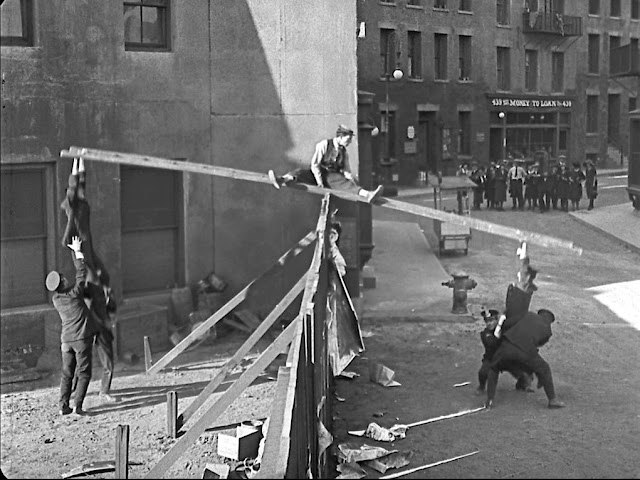Buster Keaton and American Silent Film Comedy
Comedy, in particular gag-based and slapstick comedy, was an incredibly popular genre during the silent era. In many ways, visual comedy was the perfect genre for silent cinema as gags could be shown without the need for dialogue. These visual gags could be easily understood by all audiences, including immigrant populations in the USA who may not have been fluent in English.
Early film pioneers exploited film's potential to create gag-based comedy, with whole films centred around visual jokes which could be shown within the frame of a static shot (the typical style of camerawork of early silent films).
The Lumiere Brothers' early film Le Jardinier/The Gardener or L'Arroseur Arrose/The Sprinkler Sprinkled (1895), is one of the very first examples of film comedy and the 45-second film revolves around a simple practical joke/visual gag involving a boy who pranks a gardener by stepping on his hose. As the gardener sprays himself in the face with water he spots the boy, chases him and spanks him. Like many of Buster Keaton's visual gags, the joke is allowed to develop partly because of the distance of shot used. The long shot enables the audience to see what the boy is doing, putting the viewer in a more privileged position than the gardener. These static, longer shots, became one of the conventions of the American silent film comedy movement and frequently occur throughout Keaton's short films.
Film comedy emerged in the USA as one of the cornerstone genres of cinema in the early 1910s when entrepreneur Mack Sennett founded the Keystone Company and studios. Keystone quickly gained a reputation for short, gag-based and fast-paced physical slapstick comedies - physical comedy which usually involved violent, physical action such as pratfalls, chases and practical jokes. Keystone was the biggest producer of American comedy films in the mid-1910s, with its most popular series of films being the Keystone Cops which featured inept, comic policemen.
This style of comedy can be seen throughout Buster Keaton's short films (which are dominated by physical, slapstick comedy) and the trend for mocking and outwitting policemen can be seen in both The 'High Sign' (where Keaton's character replaces the policeman's pistol with a banana) and, most obviously, Cops, where the whole narrative revolves around Keaton's character's run-ins with the Los Angeles police force.
The 1920s has come to be seen as the golden age of American film comedy. Buster Keaton was just one of many 'classic' silent clowns, including Roscoe 'Fatty' Arbuckle, Charlie Chaplin and Harold Lloyd (who all developed their craft at Keystone) and the incredibly popular Laurel and Hardy.
By the 1920s, American film studios had established the star system - a system used to create and exploit stars, where the studios would publicise films using star personas as the main selling point. Publicity departments would create a public image of the star and the star would appear in the films as this persona. the distinct personas and comedy style of the great silent film comedians were developed by the studios and this, in part, accounts for the similarity of Keaton's characters from film to film.
Many of these silent comedians were, however, given a great deal of control over their films. Keaton, for example, was allowed to set up his own production company in 1919 (Buster Keaton Productions), which gave him complete creative freedom in writing, directing and acting.
Film scholar Charles Wolfe, in Idols of Modernity (2010), lists the following conventions of American silent film, the majority of which are apparent in Keaton's work:
- falls and chase played for big laughs
- stunts which thrill audiences
- star comedians with intriguing personalities
- implausible scenarios
- stories told efficiently and clearly
- evoking of dream-like states
- critiques of contemporary American society
Buster Keaton's physical comedy developed from vaudeville, a popular form of variety entertainment in the USA from the 1880s to the early 1930s. In vaudeville shows a variety of performers, including acrobats, singers and comedians, would perform short 'skits'. It is clear that Keaton adapted his vaudeville performance of acrobatics and comedy from the theatre to the short films he made.










Comments
Post a Comment